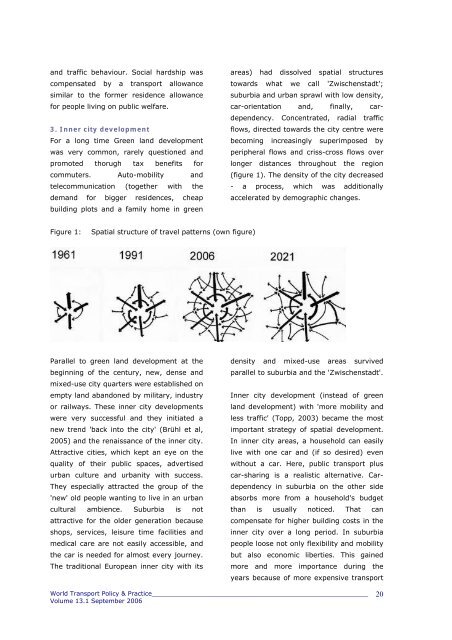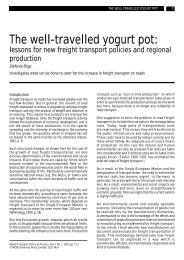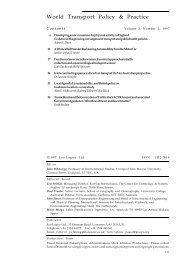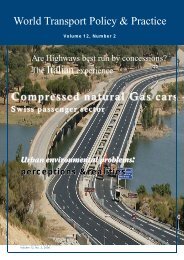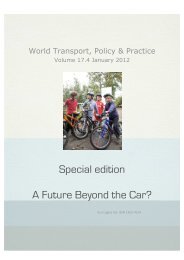Effects of pedestrianisation on the commercial and ... - Eco-Logica
Effects of pedestrianisation on the commercial and ... - Eco-Logica
Effects of pedestrianisation on the commercial and ... - Eco-Logica
You also want an ePaper? Increase the reach of your titles
YUMPU automatically turns print PDFs into web optimized ePapers that Google loves.
<strong>and</strong> traffic behaviour. Social hardship was<br />
compensated by a transport allowance<br />
similar to <strong>the</strong> former residence allowance<br />
for people living <strong>on</strong> public welfare.<br />
3. Inner city development<br />
For a l<strong>on</strong>g time Green l<strong>and</strong> development<br />
was very comm<strong>on</strong>, rarely questi<strong>on</strong>ed <strong>and</strong><br />
promoted thorugh tax benefits for<br />
commuters. Auto-mobility <strong>and</strong><br />
telecommunicati<strong>on</strong> (toge<strong>the</strong>r with <strong>the</strong><br />
dem<strong>and</strong> for bigger residences, cheap<br />
building plots <strong>and</strong> a family home in green<br />
Figure 1: Spatial structure <str<strong>on</strong>g>of</str<strong>on</strong>g> travel patterns (own figure)<br />
Parallel to green l<strong>and</strong> development at <strong>the</strong><br />
beginning <str<strong>on</strong>g>of</str<strong>on</strong>g> <strong>the</strong> century, new, dense <strong>and</strong><br />
mixed-use city quarters were established <strong>on</strong><br />
empty l<strong>and</strong> ab<strong>and</strong><strong>on</strong>ed by military, industry<br />
or railways. These inner city developments<br />
were very successful <strong>and</strong> <strong>the</strong>y initiated a<br />
new trend 'back into <strong>the</strong> city' (Brühl et al,<br />
2005) <strong>and</strong> <strong>the</strong> renaissance <str<strong>on</strong>g>of</str<strong>on</strong>g> <strong>the</strong> inner city.<br />
Attractive cities, which kept an eye <strong>on</strong> <strong>the</strong><br />
quality <str<strong>on</strong>g>of</str<strong>on</strong>g> <strong>the</strong>ir public spaces, advertised<br />
urban culture <strong>and</strong> urbanity with success.<br />
They especially attracted <strong>the</strong> group <str<strong>on</strong>g>of</str<strong>on</strong>g> <strong>the</strong><br />
'new' old people wanting to live in an urban<br />
cultural ambience. Suburbia is not<br />
attractive for <strong>the</strong> older generati<strong>on</strong> because<br />
shops, services, leisure time facilities <strong>and</strong><br />
medical care are not easily accessible, <strong>and</strong><br />
<strong>the</strong> car is needed for almost every journey.<br />
The traditi<strong>on</strong>al European inner city with its<br />
areas) had dissolved spatial structures<br />
towards what we call 'Zwischenstadt';<br />
suburbia <strong>and</strong> urban sprawl with low density,<br />
car-orientati<strong>on</strong> <strong>and</strong>, finally, cardependency.<br />
C<strong>on</strong>centrated, radial traffic<br />
flows, directed towards <strong>the</strong> city centre were<br />
becoming increasingly superimposed by<br />
peripheral flows <strong>and</strong> criss-cross flows over<br />
l<strong>on</strong>ger distances throughout <strong>the</strong> regi<strong>on</strong><br />
(figure 1). The density <str<strong>on</strong>g>of</str<strong>on</strong>g> <strong>the</strong> city decreased<br />
- a process, which was additi<strong>on</strong>ally<br />
accelerated by demographic changes.<br />
density <strong>and</strong> mixed-use areas survived<br />
parallel to suburbia <strong>and</strong> <strong>the</strong> 'Zwischenstadt'.<br />
Inner city development (instead <str<strong>on</strong>g>of</str<strong>on</strong>g> green<br />
l<strong>and</strong> development) with 'more mobility <strong>and</strong><br />
less traffic' (Topp, 2003) became <strong>the</strong> most<br />
important strategy <str<strong>on</strong>g>of</str<strong>on</strong>g> spatial development.<br />
In inner city areas, a household can easily<br />
live with <strong>on</strong>e car <strong>and</strong> (if so desired) even<br />
without a car. Here, public transport plus<br />
car-sharing is a realistic alternative. Cardependency<br />
in suburbia <strong>on</strong> <strong>the</strong> o<strong>the</strong>r side<br />
absorbs more from a household's budget<br />
than is usually noticed. That can<br />
compensate for higher building costs in <strong>the</strong><br />
inner city over a l<strong>on</strong>g period. In suburbia<br />
people loose not <strong>on</strong>ly flexibility <strong>and</strong> mobility<br />
but also ec<strong>on</strong>omic liberties. This gained<br />
more <strong>and</strong> more importance during <strong>the</strong><br />
years because <str<strong>on</strong>g>of</str<strong>on</strong>g> more expensive transport<br />
World Transport Policy & Practice________________________________________________________<br />
Volume 13.1 September 2006<br />
20


